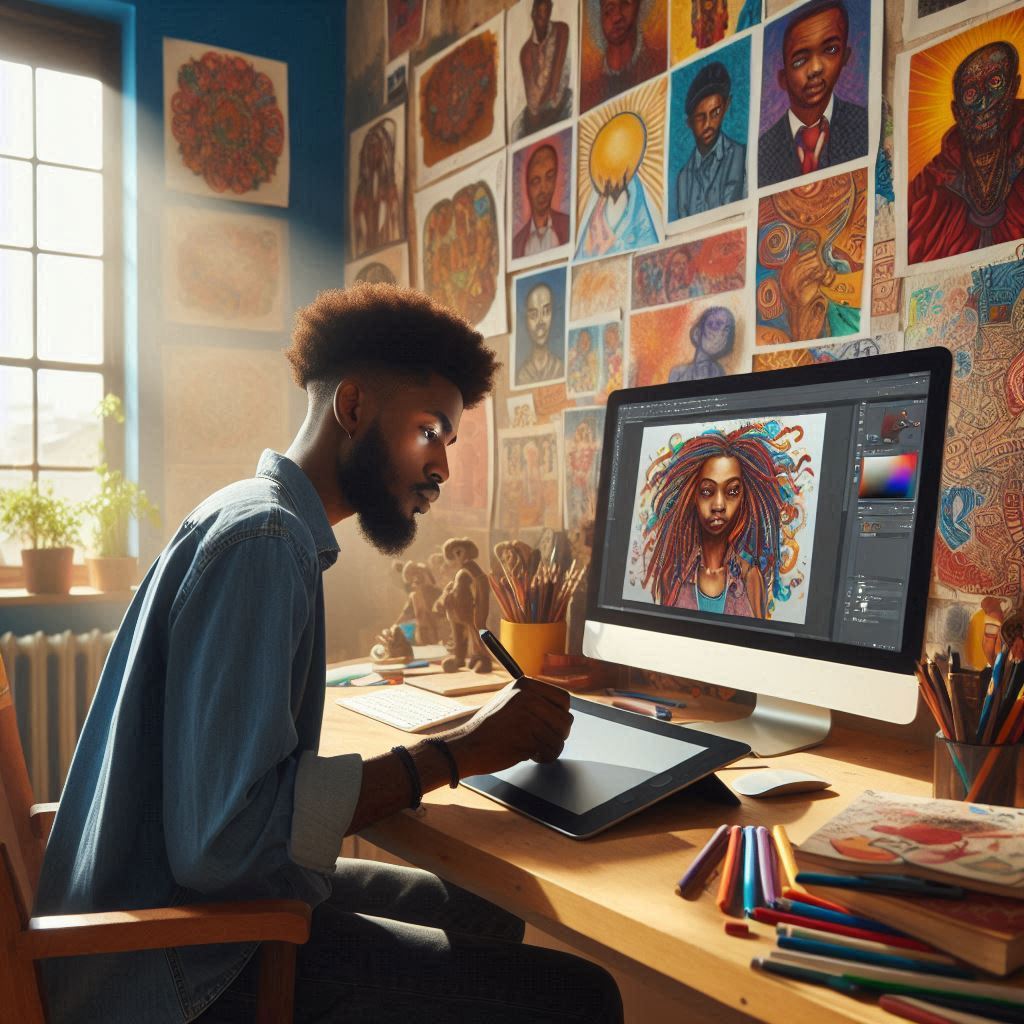Introduction
Art therapy is the utilization of creative techniques with the intention of improving mental health. This form of therapy allows individuals to express themselves through various art forms.
Definition of Art Therapy
Art therapy is a type of therapy that uses artistic expression as a means of communication and self-discovery, often helping individuals to explore their emotions and experiences.
How Art Therapy is Used for Healing
Art therapy can be used to treat a variety of mental health issues, including depression, anxiety, PTSD, and trauma.
By engaging in creative processes, individuals can gain insight, cope with emotions, and develop coping strategies.
Benefits of Using Fine and Applied Art in Therapy
Using fine art, such as painting or drawing, can help individuals externalize their thoughts and feelings, making it easier to process difficult emotions.
Applied art, such as sculpture or collage, allows individuals to engage in the tactile creation of art, which can be soothing and therapeutic.
Both fine and applied art forms can provide individuals with a sense of accomplishment and self-worth, boosting their self-esteem and confidence.
Additionally, the act of creating art can be empowering and empowering, giving individuals a sense of control over their experiences and emotions.
History of Art Therapy
Brief History of Art Therapy
Art therapy finds its roots deep in the annals of human history, stretching back to ancient civilizations such as the Egyptians, Greeks, and Native Americans.
These cultures recognized the intrinsic therapeutic value of artistic expression, using painting, drawing, and other creative activities as a means of healing and self-discovery.
However, the formalization of art therapy as a distinct therapeutic practice began to take shape in the early 20th century.
Pioneers in the field, such as Margaret Naumburg and Edith Kramer, emphasized the importance of creativity in psychological healing.
They developed innovative techniques that integrated art-making into psychotherapy sessions, laying the groundwork for modern art therapy.
Key Figures in the Development of Art Therapy as a Healing Practice
During World War II, art therapy gained significant recognition as a powerful tool for treating soldiers’ trauma.
Psychiatrists like Adrian Hill and Edward Adamson pioneered the use of art therapy in psychiatric hospitals, witnessing firsthand its profound impact on patients’ mental health and well-being.
How Art Therapy Has Evolved Over Time
Since its early beginnings, art therapy has evolved into a recognized and respected mental health profession.
It has drawn inspiration from various theoretical approaches, including psychodynamic, humanistic, and cognitive-behavioral perspectives.
Today, art therapists employ a diverse range of techniques and mediums, from painting and drawing to sculpture and collage, to help individuals explore their emotions, process trauma, and promote personal growth.
Contemporary art therapists work in a variety of settings, including hospitals, schools, prisons, and community centers.
They tailor their interventions to meet the unique needs of each client, fostering healing and self-discovery in a safe and supportive environment.
Moreover, art therapy has expanded beyond traditional psychotherapy settings to become an integral part of interdisciplinary approaches to healthcare.
It complements traditional forms of therapy and enhances holistic treatment plans by addressing the mind, body, and spirit.
As our understanding of mental health continues to evolve, so too does the practice of art therapy.
Research studies consistently demonstrate its efficacy in treating a wide range of emotional and psychological issues, including trauma, anxiety, depression, and substance abuse.
Basically, art therapy has a rich and storied history, rooted in ancient traditions and shaped by the contributions of visionary pioneers.
From its humble beginnings to its current status as a respected therapeutic modality, art therapy remains a powerful force for healing and self-expression in the modern world.
Read: Student Experiences: Life in Communication Arts
Techniques and Approaches in Art Therapy
Different Techniques Used in Art Therapy
Art therapy encompasses a wide array of techniques that utilize various artistic mediums to facilitate healing and self-expression.
Drawing, painting, sculpting, and collage are among the most commonly employed methods.
Each technique offers unique benefits and can be tailored to suit the needs of individual clients.
Each Technique Can Be Used to Address Different Emotional or Psychological Issues
Drawing allows clients to express themselves through lines, shapes, and symbols, offering a nonverbal means of communication.
It can be particularly effective in helping individuals explore complex emotions, gain insight into their thoughts, and release pent-up feelings.
Painting provides a sensory experience that engages the imagination and stimulates creativity.
By working with colors, textures, and brushstrokes, clients can externalize their inner experiences, explore issues of identity and self-esteem, and cultivate a sense of empowerment and self-expression.
Sculpting involves shaping and molding three-dimensional forms using various materials such as clay, wood, or found objects.
This tactile approach encourages clients to explore issues related to embodiment, boundaries, and relationships, as well as to process trauma and engage in therapeutic play.
Collage involves assembling images, textures, and materials to create a visual narrative.
It offers a flexible and intuitive means of expression, allowing clients to explore themes of memory, identity, and transformation.
Collage can also facilitate the integration of fragmented experiences and foster a sense of coherence and wholeness.
The Importance of the Therapist-Client Relationship in Art Therapy
Central to the practice of art therapy is the therapeutic relationship between the therapist and client.
This relationship is built on trust, empathy, and mutual respect, creating a safe and supportive environment for exploration and growth.
The therapist serves as a guide and facilitator, offering gentle encouragement, validation, and insight as the client navigates their artistic journey.
Through the therapeutic process, the therapist helps the client to explore and understand their emotions, thoughts, and experiences, facilitating insight, healing, and personal transformation.
The therapist also provides a compassionate presence, bearing witness to the client’s struggles and triumphs and offering unconditional acceptance and support.
Ultimately, the therapist-client relationship forms the foundation of art therapy, empowering individuals to tap into their creative potential, discover their inner resources, and embark on a journey of self-discovery and healing.
By fostering a collaborative and empowering therapeutic alliance, art therapists help clients to harness the transformative power of art to navigate life’s challenges and cultivate resilience, self-awareness, and well-being.
Read: Communication Arts: Balancing Theory and Practice
Benefits of Art Therapy
The Mental Health Benefits of Art Therapy
Art therapy offers a multitude of mental health benefits that contribute to overall well-being and emotional balance.
One of its primary advantages is stress reduction. Engaging in creative activities can act as a form of mindfulness, helping individuals to relax, unwind, and alleviate tension.
Moreover, art therapy promotes increased self-awareness by encouraging individuals to explore and express their inner thoughts, feelings, and experiences through artistic means.
This process fosters introspection, self-reflection, and insight, leading to greater understanding and acceptance of oneself.
Art Therapy Can Help Individuals Process and Express Their Emotions
Art therapy provides a safe and nonverbal outlet for individuals to process and express their emotions.
Through various artistic mediums such as drawing, painting, and sculpting, clients can externalize and explore complex feelings that may be difficult to articulate verbally.
This creative expression enables them to gain clarity, release pent-up emotions, and work through unresolved issues.
Examples of How Art Therapy Has Been Effective in Treating Specific Mental Health Conditions
Art therapy has demonstrated effectiveness in treating a wide range of mental health conditions.
For example, individuals struggling with anxiety disorders can benefit from art therapy techniques that promote relaxation, mindfulness, and grounding.
By engaging in calming activities such as coloring or painting, clients can reduce anxiety symptoms and cultivate a sense of inner peace.
Similarly, art therapy has been shown to be effective in treating depression.
Through creative expression, individuals can access and express suppressed emotions, alleviate feelings of sadness and hopelessness, and rediscover a sense of joy and purpose in life.
Art therapy has also been instrumental in supporting individuals recovering from trauma.
By engaging in artistic activities, clients can process traumatic memories, express feelings of fear and anger, and rebuild a sense of safety and empowerment.
Through the therapeutic process, they can find healing, resilience, and a renewed sense of hope for the future.
Essentially, art therapy offers a wealth of mental health benefits, including stress reduction, increased self-awareness, and emotional expression.
By providing a safe and creative space for individuals to explore their inner world, art therapy facilitates healing, growth, and transformation in the face of mental health challenges.
Read: Digital Media Trends in Communication Arts

Fine Art in Therapy
How Fine Art, Such as Painting and Drawing, Can Be Therapeutic
Fine art, including painting and drawing, offers a therapeutic avenue for individuals to explore and express their innermost thoughts, feelings, and experiences.
Through the act of creating art, individuals engage in a process of self-discovery, catharsis, and healing.
The Role of Creativity and Self-Expression in Healing Through Fine Art
Creativity and self-expression play integral roles in the therapeutic process of fine art.
By tapping into their innate creativity, individuals can access deeper layers of their psyche and express emotions that may be difficult to articulate verbally.
This creative expression fosters a sense of empowerment, autonomy, and agency, allowing individuals to reclaim ownership of their narratives and experiences.
Research or Case Studies That Support the Use of Fine Art in Therapy
Numerous research studies and case studies support the efficacy of fine art in therapy.
For example, a study published in the Journal of the American Art Therapy Association found that participants who engaged in a six-week art therapy program experienced significant reductions in symptoms of anxiety and depression.
Another study conducted by researchers at Harvard Medical School found that painting and drawing activities helped individuals with chronic pain conditions manage their symptoms and improve their overall quality of life.
Additionally, case studies have documented the transformative effects of fine art therapy in helping individuals cope with trauma, grief, and other mental health challenges.
Generally, fine art, including painting and drawing, offers a therapeutic medium through which individuals can explore, express, and process their emotions.
By harnessing the power of creativity and self-expression, fine art therapy facilitates healing, growth, and resilience in the face of adversity.
Read: Internship Opportunities for Communication Arts Students
Applied Art in Therapy
Applied art and its role in therapy
Firstly, Applied art is the application of artistic design to functional objects or practical items.
In therapy, applied art allows individuals to express themselves creatively while focusing on a specific outcome or purpose.
It serves as a medium for self-expression, communication, and emotional release.
Forms of applied art, such as ceramics or textile arts, can be therapeutic
Forms of applied art, such as ceramics or textile arts, can be therapeutic due to their tactile nature and hands-on approach.
Engaging in these activities allows individuals to connect with their emotions, reduce stress, and increase mindfulness.
Creating tangible objects provides a sense of accomplishment and boosts self-esteem.
The tactile and sensory experiences involved in using applied art for healing
The tactile and sensory experiences involved in using applied art for healing play a crucial role in therapy.
Molding clay in ceramics or weaving fibers in textile arts engages touch, creating a soothing sensation.
These activities encourage individuals to be present in the moment, fostering a sense of mindfulness and relaxation.
Furthermore, the sensory experiences of working with different materials, textures, and colors stimulate the senses, evoking emotions and memories.
This sensory engagement allows individuals to express themselves non-verbally and explore their inner thoughts and feelings.
Creating art through touch and sensory exploration helps individuals process emotions, alleviate anxiety, and improve well-being.
Cultural Perspectives on Art Therapy
How Different Cultures View and Use Art Therapy for Healing
Art therapy is deeply rooted in diverse cultural traditions and practices worldwide.
Different cultures have unique perspectives on the role of art in healing, with some viewing it as a spiritual practice while others see it as a means of self-expression and communication.
Indigenous cultures often incorporate art into healing rituals, believing creative expression restores balance and harmony.
The Importance of Cultural Sensitivity in Incorporating Art Therapy into Diverse Populations
Cultural sensitivity is paramount when incorporating art therapy into diverse populations.
It requires therapists to be aware of and respect the cultural beliefs, values, and norms of their clients.
Therapists create a safe and inclusive space for clients by acknowledging and honoring cultural differences.
Examples of How Art Therapy Has Been Adapted to Suit Specific Cultural Practices
Art therapy has been adapted to suit specific cultural practices and beliefs, demonstrating its versatility and effectiveness across diverse populations.
In Asian cultures, techniques like mandala-making and ink painting promote mindfulness and spiritual well-being.
In African cultures, storytelling and mask-making play integral roles in healing rituals, connecting individuals with ancestral wisdom.
Therefore, art therapy transcends cultural boundaries, offering a universal language of healing and self-expression.
Art therapists can foster healing, resilience, and empowerment across diverse populations by tailoring approaches to clients’ needs.
Conclusion
Art therapy, a dynamic fusion of creativity and healing, offers a transformative journey for individuals seeking solace and self-discovery.
Throughout this exploration, we’ve delved into the profound impact of art in fostering emotional well-being and personal growth.
From its ancient origins to its modern applications, art therapy has evolved into a revered practice, supported by research and embraced by diverse cultures worldwide.
Through painting, drawing, sculpture, and myriad other mediums, individuals find a safe haven to express and explore their innermost thoughts and feelings.
As we reflect on the insights shared, let us reaffirm the notion that art therapy is not merely an activity but a profound journey towards healing and wholeness.
I encourage each reader to consider incorporating art therapy into their own self-care regimen or exploring it as a viable treatment option on their path to wellness.
By embracing the healing power of art, we embark on a journey of self-discovery, resilience, and empowerment—a journey illuminated by the transformative potential of creativity and the boundless possibilities of the human spirit.




